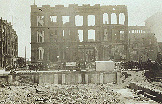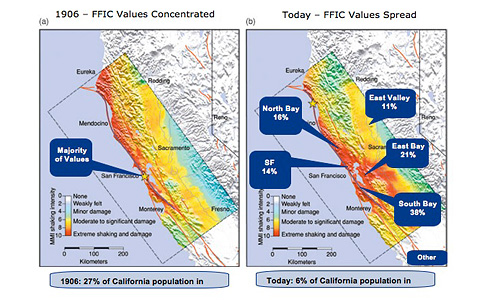"The likelihood that there will be a major earthquake along the San Andreas Fault in California is very high," said Markus Treml, natural catastrophe expert and seismologist at Allianz Re. "According to a scientific study in 2008, the chance of having one or more magnitude 6.7 or larger earthquakes in the San Francisco region over the next 30 years is greater than 63 percent; for the whole state, it is greater than 99 percent."
105th Anniversary of San Francisco 1906 Earthquake
For this reason, Fireman's Fund, one of the main California insurers in 1906 and a major property insurer today, has compared the change in population, values, and losses to form a picture of what the 1906 earthquake might look like today.
"The potential cost of earthquakes has been growing because of increasing urban development in seismically-active areas," said Doug Franklin, chief risk officer of Fireman's Fund, a US subsidiary of Allianz, one of the world's largest insurers.
Insurers today are better prepared
An earthquake today would affect more people: San Francisco has doubled in size since 1906, and Northern California as a whole has increased in population from 1 million to over 15 million people.
However, insurers today are better prepared: In 1906, 27 percent of Northern California's population was concentrated in San Francisco - today it is only 6 percent. Today's more geographically-diverse population helps spread the potential risks for insurers, as illustrated in the maps below. Insurers have also been improving their underwriting to more broadly diversify their portfolios and have put greater emphasis on adequate reinsurance.


More diversified today: Population & Values have spread (estimates based on version 9.0 of the RMS® U.S. Earthquake Model, considering alternate ground motion scenarios and post-event loss amplification)
In 1906, the total property loss was 525 million US-dollars and the insured loss was 235 million US-dollars. Today, this ratio would be lower. Potential losses today from the exact same earthquake as happened in 1906, could be well over 200 billion US-dollars and insured losses are expected to range between 30 and 60 billion US-dollars.
Fewer people and businesses have been purchasing earthquake insurance. A 2006 poll by the Insurance Information Network of California and Fireman's Fund, found that only 22 percent of Californians consider themselves to be prepared or very prepared for a disaster in their area.
"Only about 12 percent of homeowners in California purchase earthquake coverage," said Franklin. "Despite California's history of catastrophic earthquakes, wildfires and floods, many people feel that the West Coast offers them a relatively safe environment."
Since Japan earthquake more policies purchased
Since the recent earthquake in Japan, AM Best reports a few thousand more earthquake policies have been purchased.
Experts believe that proper prevention, preparation and information are key to decreasing potential losses. Fireman's Fund employs a significant number of risk prevention experts who help customers improve their buildings to keep risks as low as possible.
"The risks that earthquakes mean for society, including loss of lives, injury, and economic loss, can be greatly reduced by better planning and mitigation practices beforehand and providing timely information to improve response after they occur," said Franklin.
Preparation tips for homeowners include:
- Evacuation plan and supplies for your family members
- Inventory the contents in your home, and record them with video or photos
- Automatic Gas Shut-off Value: One of the largely unexpected, but potentially devastating, aftereffects of an earthquake is a structure fire caused by gas leaks in broken gas lines. Two types of automatic shutoff valves can prevent this: the seismic gas shutoff, and the excess flow shutoff. When a seismic gas shutoff valve senses a major earthquake, it automatically closes off the gas supply to the home – or to a second home at a remote location in the earthquake zone. The excess flow shutoff is actuated by a significant increase in gas flow rather than by seismic activity. Both valves should be installed on the homeowner's side of the gas main by a licensed contractor
- Water Heaters: Strapping a gas water heater to the nearest wall can prevent the danger of fires caused by gas leaks from broken gas supply hoses. Local Construction codes in your area may specify how the water heater should be strapped
- Securing fine art, collectibles and other valuables: Framed pictures should be securely fastened to the studs of solid parts of walls with special fasteners to prevent them from falling. Free-standing sculptures, figurines, objects of art and other display items should be braced or secured to their shelves or display stands. A fine wine collection should be enclosed in a wine cellar, rack or refrigerator that prevents the bottles from rolling or falling in an earthquake
- Foundation bolts: Foundation bolts unify the home with its foundation and hold them together in an earthquake. This can prevent a major earthquake from shifting the house off its foundation, causing additional damage
- Concrete foundations: Brick foundations may crumble or separate during a powerful earthquake, allowing a home to collapse. Experts recommend replacing brick foundations with reinforced concrete
- Seismic bracing and shear walls: Shear walls prevent sway, the back-and-forth movement of a structure in a strong earthquake that can cause a house to tear itself apart and collapse. Shear walls hold the walls together as a unit, reducing or eliminating sway
As with all content published on this site, these statements are subject to our Forward Looking Statement disclaimer.
Link to the disclaimer